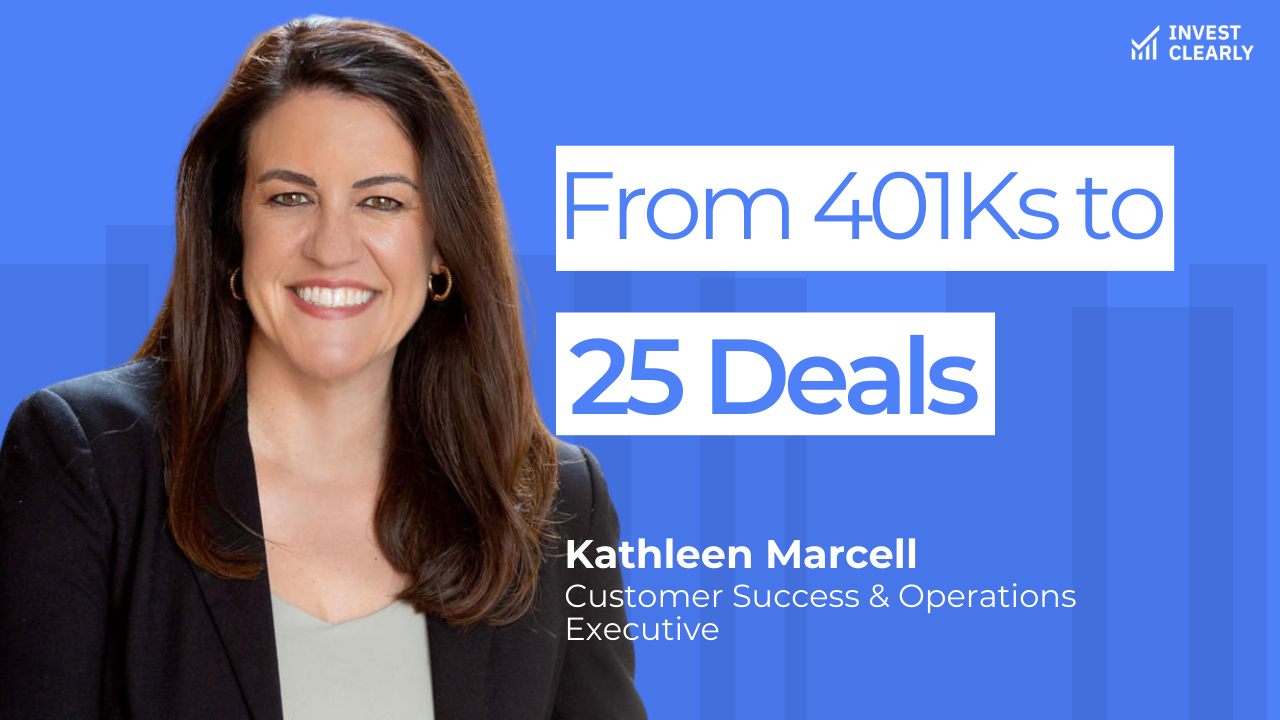
How a Part-Time LP Finds Deals and Lowers Minimums with Kathleen Marcell
Never miss an Invest Clearly Insights article
Subscribe to our newsletter today
In this conversation, Kathleen Marcell shares her journey from traditional investing to exploring alternative investments. She discusses the evolution of her investment strategies, the importance of building deal flow, and aligning investments with personal goals. Kathleen emphasizes the significance of evaluating track records and effective communication with general partners. She also highlights her current investment strategy, focusing on cash flow opportunities and the challenges faced in passive investing. Throughout the discussion, Kathleen provides insights into her research process and the importance of education in the investment space.
How a Part-Time LP Finds Deals and Lowers Minimums with Kathleen Marcell
Introduction
[00:00:27] Pat Zella: Welcome back to the Invest Clearly Podcast. I'm your host and CEO of Invest Clearly, Pat Zella. In this episode, we hear from Kathleen, a part-time passive investor with a portfolio spanning 25 syndication deals. Kathleen shares how she assesses sponsor credibility, what she looks for in communication cadence, and the red flags that make her walk away. We also explore how her due diligence has evolved from checking references to watching how sponsors handle underperformance. Let's get into it.
Interview
[00:01:12] Pat: Kathleen, thank you for joining me today. You've been an awesome contributor to Invest Clearly, so I really appreciate that and you coming on to share your story. Before we get started, do you want to take maybe 30 seconds to tell us a little bit about yourself and your background? Do you invest full-time? Do you have a W2 as well?
[00:01:34] Kathleen Marcell: Absolutely. So I'm Kathleen Marcell. I'm married to my husband Jared. We have two young kids, and we both work W2 jobs in the tech space. I've always been kind of the traditional investor—I was always in 401Ks and the stock market. About three years ago, I learned about this other world of alternative investments and did a ton of research. It really opened my eyes to what's possible and what's out there.
My husband and I turned it the other way—we stopped investing in the 401Ks and really started doing a lot of work in all things alternative investments. I still feel like I'm early on, just a few years in, but I've learned a great deal and am really excited to be on this path to eventually be in a place where we just have more work freedom and can choose how we're spending our days and our time, not being completely locked into having to do the W2 full-time work.
[00:02:42] Pat: That's awesome. I remember when we first met, your journey started—and keep me honest here—your first investment, there wasn't a lot of due diligence around it. You kind of went into it pretty hot. I'd love to know, from that experience, how has that evolved to how you're looking at things now?
[00:03:06] Kathleen: Yes, things have certainly changed since the early days. Once I did enough research and thought, "Okay, this makes sense," I started talking to GPs and understanding what was out there. I would do a couple calls a week just to understand, but deal flow was pretty minimal. It was really hard for me to even find deals. Because of that, I felt like I was settling. I'd think, "This looks interesting," and I would try to do a Google search and say, "Okay, great, let's try it."
Now I have a much lengthier process. I think part of it was just wanting to do that first investment. I thought once I got one under my belt, I'd feel more confident. But everyone that we've done has taught me something else to figure out what makes sense for us and for our goals. Now that I have way more deal flow—deals coming into my inbox every day—and I have different places I can look and networks I can go to, it makes it much easier to make a strong decision. Before, they were few and far between, so we would pick based on the best of what we had access to.
[00:04:29] Pat: Sure. We recently had Leila Komoto on, who's a professional LP. She does this full-time, and one of the biggest things she said for people to focus on early on is deal flow. How have you built that up? Where are your deals coming from now?
[00:04:43] Kathleen: Yeah, a lot of it was just having conversations over time. I listened to a lot of podcasts, and I'll hear about an investment firm or GP that I want to work with, reach out, and set up time. Then you can get on lists. I'm on a ton of different lists right now. And then it's using sites like yours, going on Invest Clearly to see what ones have a lot of good reviews, and doing my own research. I reach out and set up time to talk with those folks. And there are a few other networking-type groups. That gets names on my radar, and then I'll do research: What types of deals do they do? How long have they been in business? What's their track record? Then I decide if I want to learn more and set up time to talk with them.
[00:05:29] Pat: Sure. Very cool. You mentioned goals and future-looking lifestyle. How do you evaluate your strategy when it comes to aligning to those goals? Are there certain asset classes you're looking at? Only certain returns? Certain geographies? What is your buy box or strategy currently?
[00:05:51] Kathleen: Yeah, and that's definitely changed quite a bit. Early on, we were both in W2 jobs, and I thought, "We don't need the cash flow now. I'm going to do more equity deals." So that's what we did. Over the past few years, there have been a lot of changes in the economy. We both work in the tech space, and from more of a security perspective, we've kind of changed that. Being able to get these deals cash flowing—ideally within the first six months to a year—is really important now. Having some sort of cash flow coming in is a really important piece.
Then I'm looking at the timeframe. I prefer shorter term, which I would say is three to five years. I don't want something that's going to be locked up seven to ten years. The track record of the investor is a big one, so making sure they've been doing this and have strong metrics for the past ten-plus years. And then distribution—what can we expect from a cash flow perspective? Just having a number that we're comfortable with as we're transitioning to more cash flow with equity, as opposed to just the pure equity deals that we started with.
[00:07:12] Pat: Sure. Makes a ton of sense. You mentioned track record. Track record seems to be a very hot topic right now in terms of validation, simply because of the environment we're coming out of or even in the middle of. Are there any specific things you ask to validate track record beyond just "How have you done over the past few years?"
[00:07:33] Kathleen: Yeah, so I try to look at—or have them talk me through—a specific fund. Maybe we're talking about Fund 4, so I'll ask, "Where are you at on Fund 2? How is that performing compared to what your pro forma was?" I will also always have GPs send me the latest update that they sent out to their investors. For the most part, they're ready and willing and can do that in a click of a button. Others that are hesitant to do that or don't follow through on that—that's a big red flag for me. I want to see how you're communicating and what those updates look like. That's been a big piece.
Again, we've been at this for about three years. Some are great with communication and just make you feel like you're in the loop every step of the way. Others, I'm like, "I haven't heard from you in six months. What is going on?" Being able to just see how they respond to that request gives you a lot of clarity into past deals. And they should have metrics—whether it's on their site or in their deck—of actual performance over time. Talk to me about a deal that went full cycle. If they haven't seen that yet, it's probably not the investor that I'm looking to work with.
[00:08:51] Pat: For sure. That's such great feedback on having the communication sent to you, because that is the number one thing LPs are focusing on right now. But it's so difficult to validate effective communication from three deals ago or something like that beyond, "Hey, show me the consistent communication that has gone out." I would say even on the communication side of things, people aren't concerned about negative communication—it's just "How are they communicating?" Like you said, it's been six months, I want to know what's going on here. So that's great feedback.
In terms of—are you still—you mentioned some forward-facing goals of moving towards that investment process to get out of the W2. Are you placing capital right now or are you on a wait-and-see strategy? What's your strategy right now?
[00:09:44] Kathleen: Yeah, no, we're continuing to deploy capital as we get it, even with everything that's going on in the world. I'd say we've shifted a little bit away from full real estate. We did a lot in multifamily early on and put a bit of a pause there with everything going on. But we've been doing more in oil and gas. There are some really interesting tax benefits for us both being W2. We just recently invested in a medical office fund, so that's another piece that—just as you're learning about stability and the economy—those have been doing really well.
So just continuing to understand what's out there. But yeah, continuing. I know the economy—there's a lot going on in today's climate—but I think that's just part of it. We have to navigate through it. Another piece I'll say in my buy box or my thesis is I don't spend a ton with one investor, especially being early on. Every time I talk with someone, I'm like, "Hey, new relationship. Are you willing to cut that in half? So instead of putting a hundred, can I do 50?" And for the most part, I've gotten a really good response to that. That has allowed us to participate in many more deals than I think we would've been able to otherwise, and makes me a bit more comfortable that we're not deploying as much capital. Prove out this works, and I'll gladly work with you more in the future. So we've been continuing to invest but using that mentality.
[00:11:32] Pat: Yeah, that's great. Why has someone said no to that? And besides a personal risk factor of "I want to test you out," is that a red flag if someone doesn't lower their minimum? Is that a weird thing where, "Hey, this is the first time we're doing something, I'm testing out a relationship with you. Why wouldn't you lower this and then earn my trust for forward-looking investment?"
[00:11:54] Kathleen: Yeah. I feel like for the most part I've gotten, "Yeah, and we've been able to do it." I think a few people have been like, "That's not what we do. If it's really important to you, we will." So I think it just depends on their particular circumstances. Feedback that I got from one investor was that sometimes when people are putting in less capital, they're the more needy investors, wanting all the updates and all the things. And I'm like, "I assure you that will not be me. Full trust. But we just need to—we're still new at this. I feel like I'm still learning, and I want to be careful. I want to make sure that this works." So this gives me more of a comfort level to get in there and still understand what I'm doing. I'm still doing the due diligence, but not putting everything in one basket.
[00:12:49] Pat: Yeah. That's great. So you mentioned shifting from what I would say mainstream real estate to these alternatives that are more operations-plus-real estate, the oil and gas. I guess medical office is still pretty core, but you're like the fifth or sixth person on this podcast that has brought up oil and gas lately, and it's a wild trend. It's not something—we're starting to see it on Invest Clearly. There are more sponsors getting involved in the oil and gas space. I have never seen someone bring it up with the consistency people are lately.
So that leads to my question about due diligence. As you shift into these new asset classes—maybe for the first time—that are a little different than mainstream real estate, how does your underwriting change? Are you focused more on the jockey? Are you focused more on the operations? You mentioned tax benefits for oil and gas. Is that the primary driver for what you're going for there? What does that look like as you're making those shifts?
[00:13:45] Kathleen: Yeah, I mean, I think the tax piece kind of got me interested. I started listening to a lot of podcasts in that realm and started talking to a lot of operators just to learn what that looks like. I think early on I was so scared of it because you hear about these oil and gas investments where they go to drill and then nothing's there and you completely lose your investment. So for me, I'm like, "Nope. Scary."
[00:14:14] Pat: Yeah.
[00:14:14] Kathleen: But then you're like, "Okay, why are people doing this? I need to look into this further." And then you understand the different tiers that are involved. So a fund that I'm looking into currently, they only operate in Tier 1. And so you're working with the large gas producers of the world—all the big brands that we would think about. So there's lower risk when you're operating within that tier. Being able to understand what you're setting yourself up for, what that looks like, and understanding really what the real risk is—because no, I'm not going to do one of those where you could potentially lose all of it. Sure, the upside could be great, but that's super risky.
Whereas learning about the Tier 1, and this investor that we're talking about now, the investors get 94% of the proceeds. So the actual GP or the operator is getting 4% until all investors make their initial capital back. And so that's another huge piece—understanding how these operators are making their money. Because if they're only making 4%, they are extremely motivated to get everyone their money back. And then that turns into a new distribution. I think it goes down to 75/25, something like that, which is when they make their money. So they are motivated to get us our money quickly and make that work. And so I love deals that are set up in that way. Understanding how are you making your money, what are the risks—that can shed a lot of light on if it's a good deal or not.
[00:16:38] Pat: You mentioned quite a bit about the research you do before going into a deal. You're listening to podcasts, you've got your deal flow. How much research—what does that process look like for you? When do you feel ready to invest in one of these deals? How many are you looking at? How much research are you doing? Walk us through that strategy.
[00:16:59] Kathleen: Yeah, so first I would say I'm doing enough research to really understand what the opportunity is and how it works. All of these I am investing with my husband, but I would say I'm the one doing all of the research. I love learning about all this. So my point is, can I go to him and explain this and how it works and how we're going to make money? That's been really helpful—okay, I understand oil and gas enough. I'm like, "Hey, can I run this by you tonight?" And I'm explaining and answering all his questions. So being able to confidently explain what that looks like.
The other advice that I got along the way was, after a call with a GP, respond to them in your own words of what you think you learned and have them validate, "Did I actually understand it?" Because it's been interesting—I feel like some of these people in oil and gas have really educated me along the way. I'm like, "Okay, this sounds great. Let me go talk to three, four, five others and then decide who do I feel like I can work with? Who has really been open when I've asked for a past report and email and they can send it in one second and it meets my criteria—it's from a few weeks ago that they sent out?" So that goes a long way.
I'd say part of it is just comfort level. But it's also me being able to say, "Okay, I confidently understand what this is, what the risks are, what all of this looks like." And then I'm like, "Okay, I can stand behind putting our dollars here and I can explain it all to my husband, my investing partner," and he's like, "Okay, this makes sense." So I don't think it's a set number, but I'm never just talking to one or two people. It's definitely a handful.
[00:18:54] Pat: That's really cool. I mean, very basic, right? That's what they say—can you know it well enough to explain it to someone else? If you don't, you don't know it well enough. So that's fantastic.
So we talked a little bit about this, but obviously Invest Clearly is really based on trust. You touched on really them sending the communication, them validating what you learned, and walking you through the educational piece along the way. Besides just the deal due diligence and understanding that, what gets you to trust a GP? When you're evaluating the actual jockey, what does that trust process look like? And is there a red flag where it's like, "Okay, besides track record—which you talked about—I thought this might have been the right person. It's not based on this one or two things"? What does that look like for you?
[00:19:44] Kathleen: Yeah, I mean I think an initial signal is just that they're willing to jump on the phone and give you time. I'll explain, "Hey, I'm a newer investor. This is new to me." And the people that are really willing to take the time and explain how they think about things and answer my hundreds of questions—that certainly goes a long way.
But yeah, it is finding information out there. I will always go on Invest Clearly and take a look at what other people are saying. I throw their name in Google as many different times or ways as I can and try to get in there and find any information. I'll listen to them on podcasts. So I think you just have to connect with them in terms of what they're trying to do, understand how they got into the business, how they make money. If we can all align on that, and then what is the deal—what does that look like? We talked about distributions and all of that. So is it a percentage that I think is fair and makes sense? Because they all look very different. But if I can understand how it can benefit me and them, and I feel like there's someone I want to work with and I will be okay working with in five years—because these aren't short-term things—that all goes a long way.
[00:21:09] Pat: Yeah. Fantastic. And Kathleen, I should have asked you this earlier in the episode, but what is your portfolio makeup currently? How many deals are you in? And then how is it performing right now?
[00:21:21] Kathleen: Yeah, so we're probably in about 15 deals, really spread across—I'd say maybe half of that is in multifamily. That's what we did a lot of early on. But we have some self-storage in there, the medical office, I have a mobile home fund—so it's a little bit of everything. We've done some new builds, some development projects, more in the multifamily space, so certainly a number of different things. Private credit is something newer that we've invested in this year. So certainly a diversified portfolio.
In terms of how it's performing, we just had our first deal this year that went full cycle, which was exciting to finally see that. And it was great—even better than we were expecting. So that was exciting to have the first one under our belt. And then really it's only been over the past six months that I've redefined our investment thesis and focused more on the cash flow. So we're just starting to see that. And then some of these early deals that we invested in three years ago—a lot of those are at the final stages now. So then we're taking those and reinvesting them into cash flow deals to focus a bit more on that. And then I think we'll be able to see it in real time.
It's been a bit of a waiting game with some of the early investments. But for the most part, everything's been going well. The development projects, certainly more delays there than I would've expected. I think I learned a lot—those are very much subject to change. So a lot of those have been pushed back a bit, but still look promising.
[00:23:15] Pat: Yeah. Great. And are you seeing, now that you have shifted your investment thesis to more cash flow-based, are you seeing many cash-flowing deals in today's environment?
[00:23:25] Kathleen: Yeah, I mean I think there are. Depending on funds, private credit is another really interesting one to look into. I feel like those have popped up. Like you said, the oil and gas—I feel like private credit is another piece that is everywhere right now. I think just in this economic climate, people are feeling more comfortable with that. But yeah, I think sometimes it may be a little harder to find, but they're certainly out there.
[00:23:52] Pat: Yeah. That's great. Yeah. I'm hearing a lot about private credit. I'm hearing a lot about oil and gas. And more recently I've been hearing a lot about senior living. Have you looked into any of those?
[00:24:02] Kathleen: Yeah, we have two of those in our portfolio, which are both working well. One is really interesting though with the labor shortage, which is again something I would not have thought of. They're doing really well, but they're having a lot of turnover and having a hard time retaining nurses and things in this community up in Wisconsin. So again, it's just one of those things where you don't think about that. You initially see this elderly population, people are definitely moving into assisted living, but then you don't think about the staff and the nurses there.
But this sponsor has been great and they're very communicative with how they're working through that and what that looks like. So even though it's been challenging for them in that regard, I feel like we're in the loop and it's still been really consistent from a distribution perspective.
[00:24:54] Pat: Sure. That's great. Yeah. And it's funny, those external—I guess maybe macro-based environment—things that people don't take into consideration that have huge impacts. We had someone on recently, his name's Jeremy, and he was talking heavily about these external factors that LPs just don't necessarily think about. You look at the deal, you underwrite the deal, there it is. And then all of a sudden these things come out of nowhere and it's like, "Oh man. Well, at least you know for the next time."
Alright, Kathleen, I know we're heading towards the end of the episode and I have to ask the question I love asking on every show: What part of past investing do you think needs to die?
[00:25:31] Kathleen: I would say the part that it is pure risk and these alternative investments are scary. The more I've learned, I feel like the traditional path of 401Ks and the stock market is actually much scarier when you understand how little control you have over it. So even if it feels risky or scary at first, get educated. There is so much opportunity in the world of alternative investments.
[00:26:01] Pat: Awesome. And in terms of education, you've mentioned podcasts, deal flow, getting on the phone with sponsors. Is there anything else you recommend to get up to speed quickly that you've leveraged that other people should as well?
[00:26:14] Kathleen: I think just books, podcasts. That's been huge. And yeah, if you can get yourself in any sort of community just to learn from other people, that has been really helpful as well.
[00:26:26] Pat: Awesome. Awesome. Kathleen, thank you so much for doing this with me. We value your support and participation on Invest Clearly. It's been great getting to know you. I'm looking forward to continuing our relationship. If people want to get in touch with you, how should they?
[00:26:39] Kathleen: Yeah. I'm on LinkedIn. You can send me a message. You can find me there. That's probably the easiest way.
[00:26:47] Pat: Awesome. Awesome, Kathleen. Thank you so much.
[00:26:49] Kathleen: Yeah. Great chatting with you, Pat.
[00:26:50] Pat: Alright, bye.
Written by
Invest Clearly empowers you to make informed decisions by hosting unbiased reviews of passive investment sponsors from verified experienced investors.
Other Articles
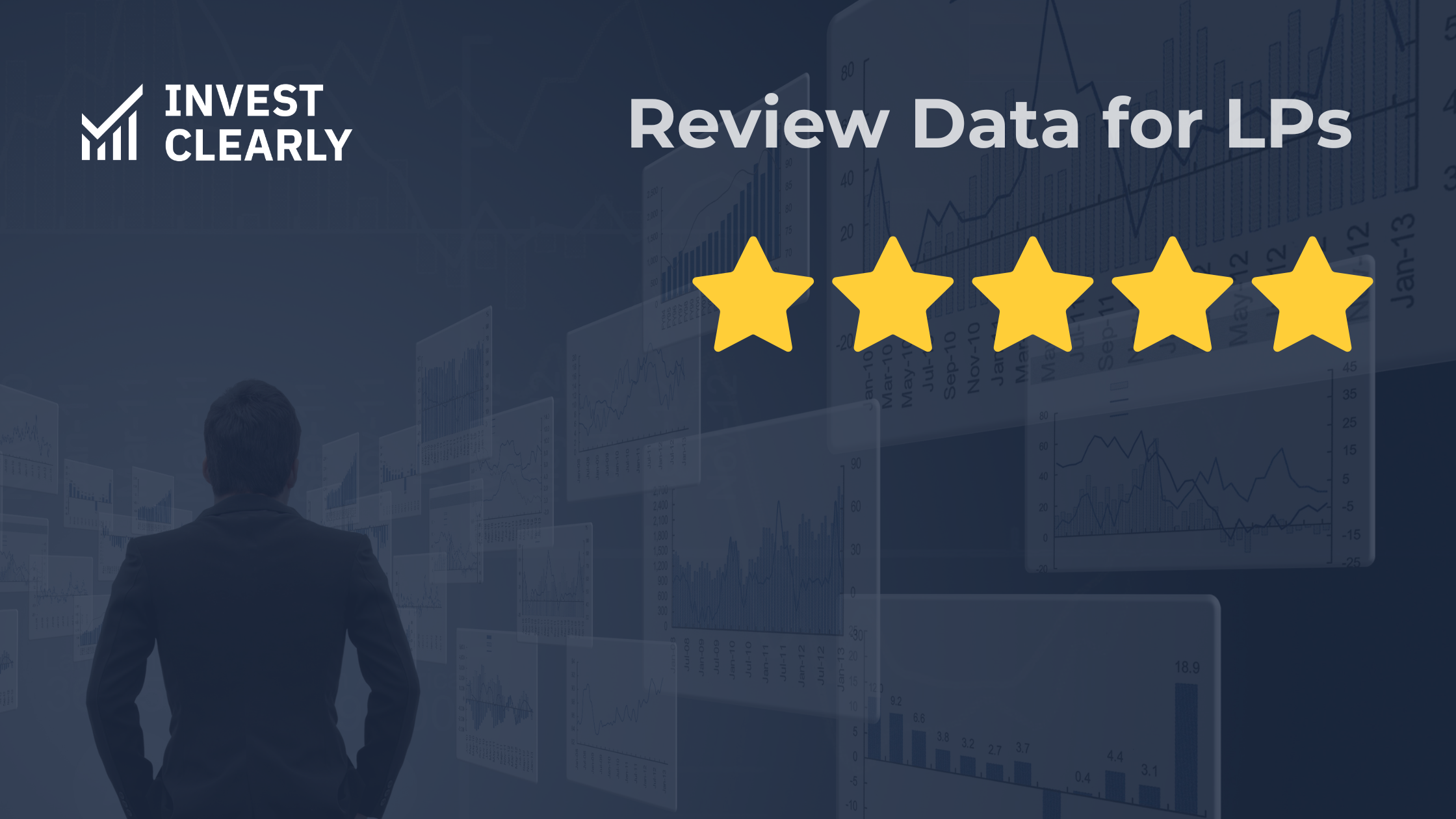
Investor Experience Index Q3, 2025: LP Takeaways
Discover quarterly insights of how LPs rate their experiences with GPs. Get data-driven questions to use when evaluating GPs.
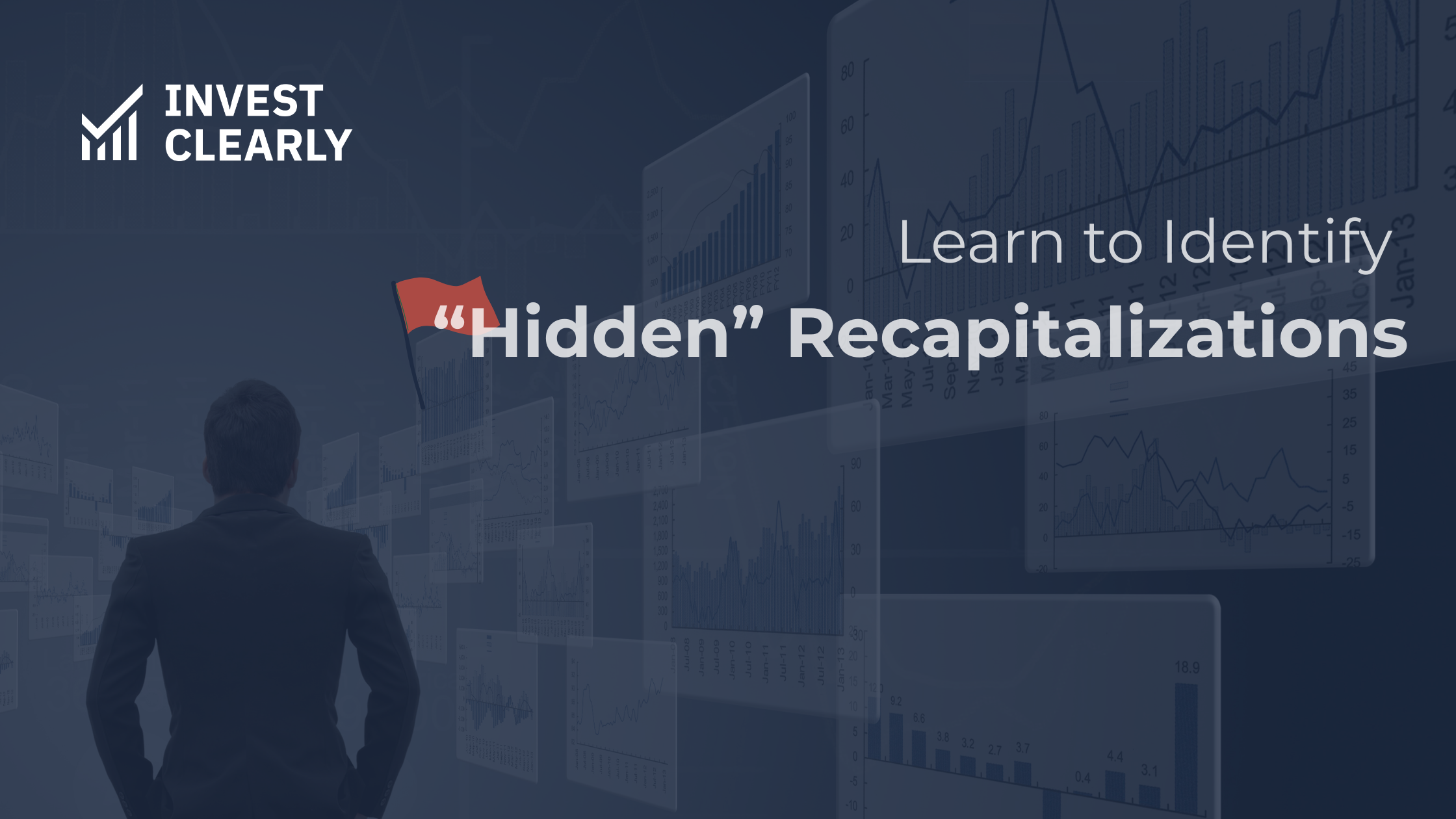
Real Estate Recapitalizations—What Passive Investors Need to Know
A recapitalization is a restructuring of a property's capital stack (the mix of debt and equity that finances an investment). While they can be legitimate business strategies, transparency can be an issue.
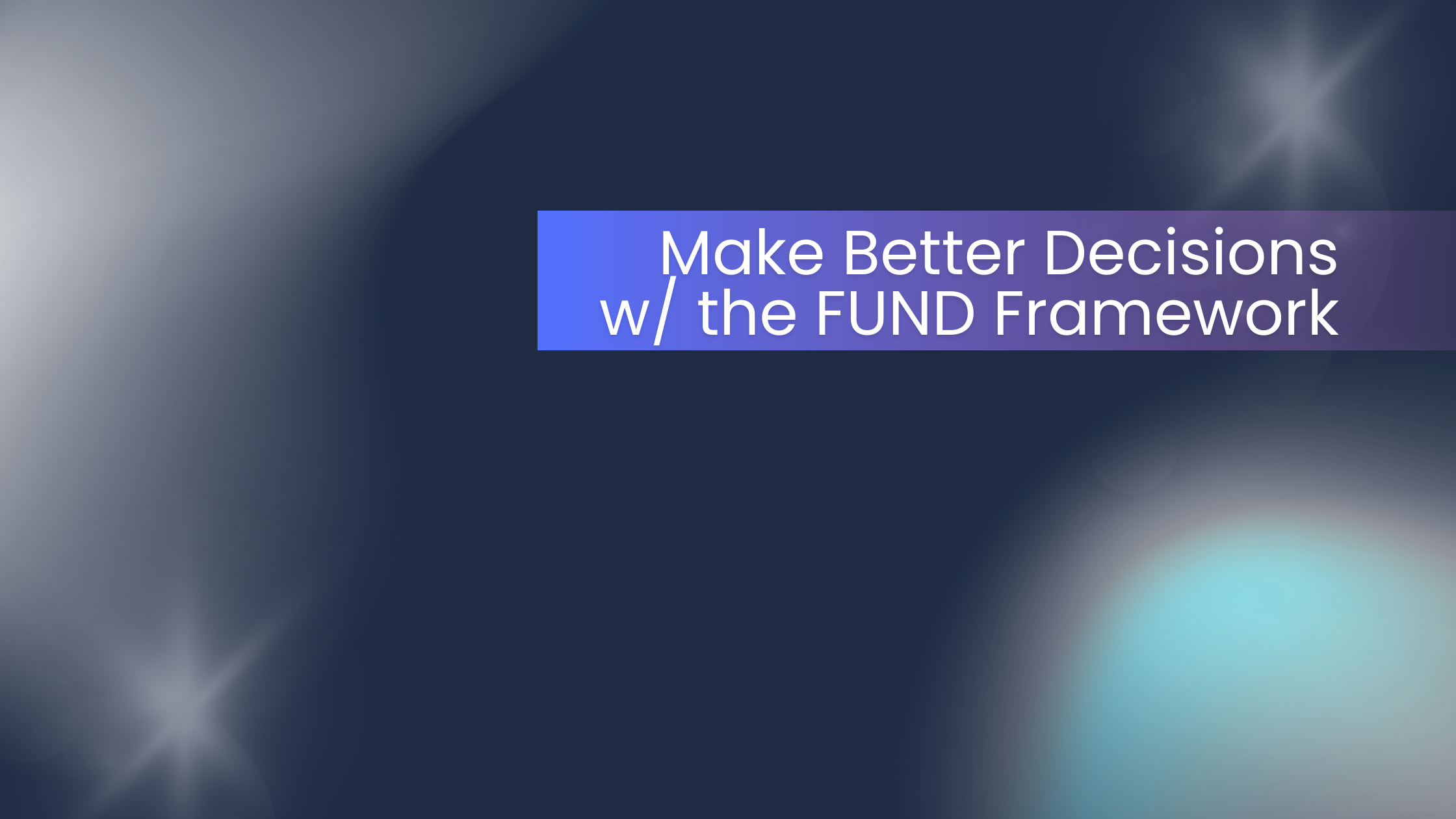
How to Evaluate a Potential Investment Using the FUND Framework
The FUND framework is a simple way to evaluate opportunities by looking at four pillars: Financials, Underlying Assets, Notable Differentiator, and Delegation of Responsibilities.
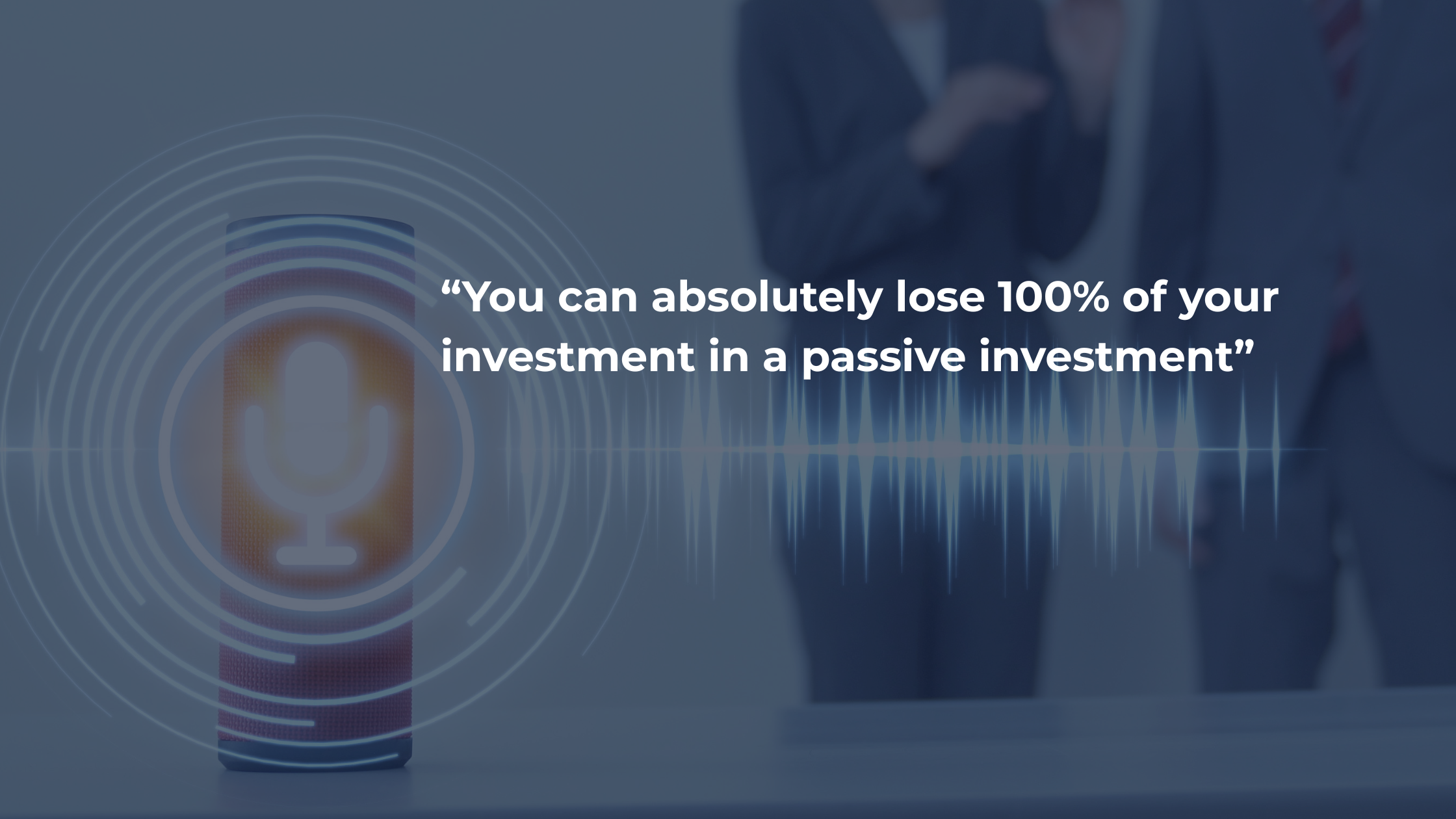
What Needs to “Die” in Passive Investing – According to Guests of The Invest Clearly Podcast
Get the answer to the closeout questions of each podcast episode: “What do you think needs to die in passive investing?” The answers are wide-ranging, from misconceptions about risk, to misleading marketing tactics, to structural issues in how deals are presented.

Passive Real Estate Investing Advice from Experienced LP Investors
Experienced LPs shared their most valuable lessons, drawn from years of investing across various asset classes and sponsor relationships.
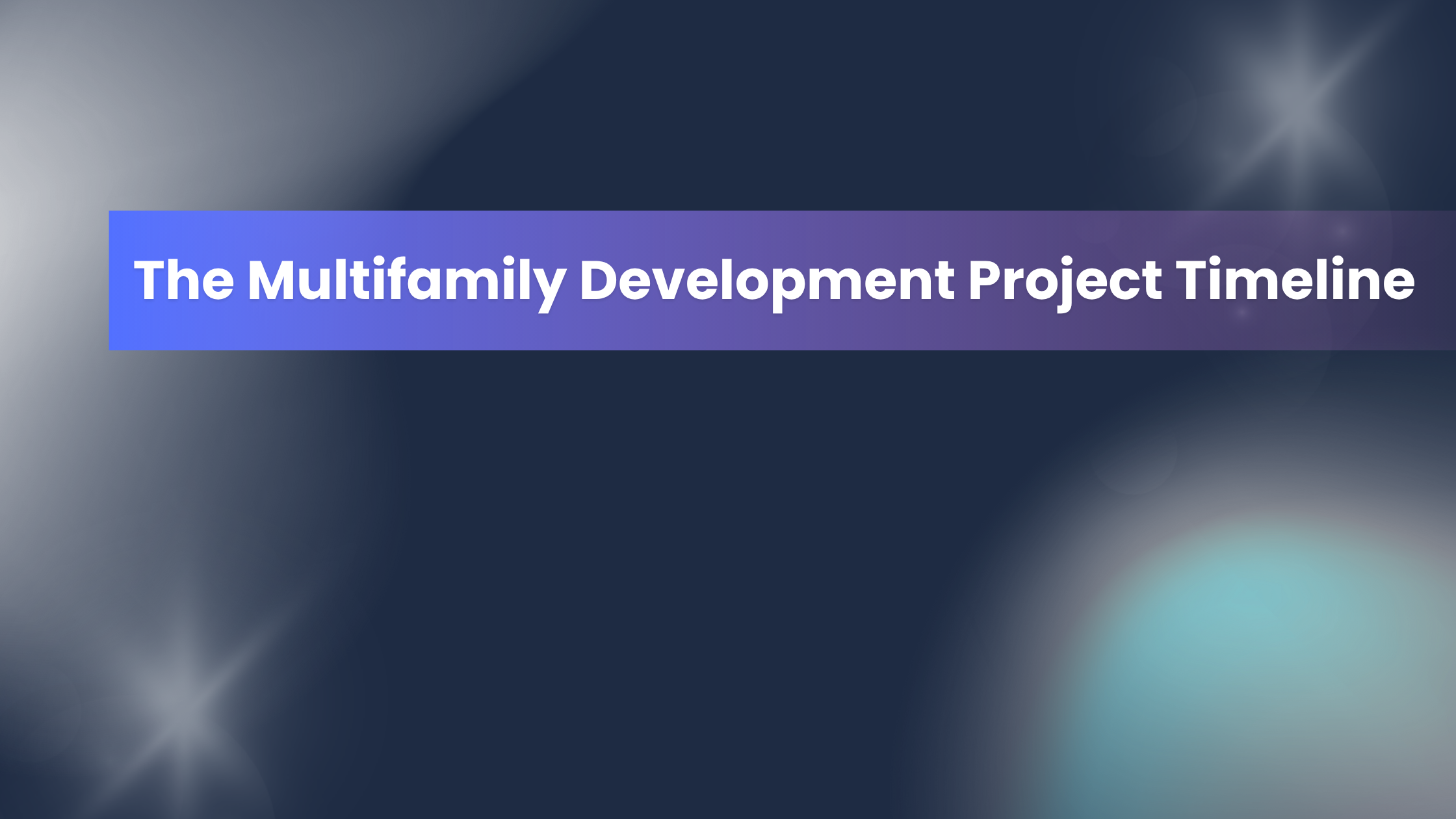
From Land to Lease-Up: The Lifecycle of a Multifamily Development Deal for LPs
This guide walks you through the typical timeline of a multifamily development project from the LP perspective. Learn when investors come on board, what happens during construction and lease-up, and how profits are realized at exit.